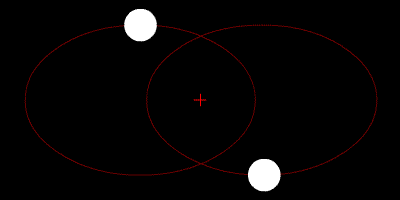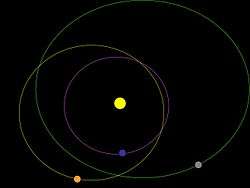58534 Logos
| Discovery | |
|---|---|
| Discovered by |
C. A. Trujillo, J. Chen, D. C. Jewitt, J. X. Luu |
| Discovery date | February 4, 1997 |
| Designations | |
| MPC designation | 58534 Logos |
| Pronunciation | /ˈloʊɡɒs/ LOH-goss or /ˈlɒɡɒs/ LOG-oss |
Named after | Logos |
| 1997 CQ29 | |
| Cubewano[1] | |
| Adjectives | Logian |
| Orbital characteristics[2] | |
| Epoch August 27, 2011 (JD 2455800.5) | |
| Aphelion | 50.50 AU |
| Perihelion | 39.675 AU |
| 45.09 AU | |
| Eccentricity | 0.1201 |
| 302.8 a (110589 d) | |
Average orbital speed | 4.41 km/s |
| 55.52° | |
| Inclination | 2.9015° |
| 132.612° | |
| 334.74° | |
| Known satellites |
Zoe[3] (~66 km in diameter) |
| Physical characteristics | |
| Dimensions | 77 ± 18 km[4] |
| Mass | 2.7×1017 kg |
Mean density | 1.0 g/cm³ |
| 0.0112 m/s² | |
| 0.0299 km/s | |
| Albedo | 0.39 ± 0.17[4] |
| 6.6 | |
|
| |
58534 Logos (/ˈloʊɡɒs/ LOH-goss or /ˈlɒɡɒs/ LOG-oss; or as in Greek: λόγος) is a small Kuiper-belt object, more specifically a cubewano, notable for having a comparatively large satellite named Zoe. For a small KBO, about 80 km in diameter, it has a very high albedo.[4] The system mass is 4.58 ± 0.07×1017 kg.[5]
In the Gnostic tradition, Logos and Zoe are a paired emanation of the deity, and part of its creation myth.†
Zoe

Logos is a binary with the components of comparable size orbiting the barycentre on a moderately elliptical orbit.
Logos' companion was discovered on 17 November 2001 from Hubble Space Telescope observations by K. S. Noll, D. C. Stephens, W. M. Grundy, J. Spencer, R. L. Millis]], M. W. Buie, D. Cruikshank, S. C. Tegler, and W. Romanishin and announced on 11 February 2002.
After the discovery, it received the provisional designation S/2001 (58534) 1. Once confirmed it was officially named (58534) Logos I Zoe (/ˈzoʊ.iː/; from Greek: Ζωή). It orbits Logos with a semi-major axis of 8217 ± 42 km in 309.9 ± 0.2 d with an eccentricity of 0.546 ± 0.008.[5] Its estimated diameter is 66 km,[3] and mass (0.15 ± 0.02)×1018 kg.
Orbit

References
- ↑ Marc W. Buie (2003-05-31). "Orbit Fit and Astrometric record for 58534". SwRI (Space Science Department). Retrieved 2008-09-28.
- ↑ JPL Small-Body Database Browser
- 1 2 Wm. Robert Johnston (2007-03-04). "(58534) Logos and Zoe". Johnston's Archive. Retrieved 2009-10-06.
- 1 2 3 Grundy, W. M; Noll, K. S.; Stephens, D. C. (2005). "Diverse albedos of small trans-neptunian objects". Icarus 176 (1): 184–191. arXiv:astro-ph/0502229. Bibcode:2005Icar..176..184G. doi:10.1016/j.icarus.2005.01.007. (Preprint on arXiv.)
- 1 2 Grundy, W. M.; Noll, K. S.; Nimmo, F.; Roe, H. G.; Buie, M. W.; Porter, S. B.; Benecchi, S. D.; Stephens, D. C.; Levison, H. F.; Stansberry, J. A. (2011). "Five new and three improved mutual orbits of transneptunian binaries" (pdf). Icarus 213 (2): 678. arXiv:1103.2751. Bibcode:2011Icar..213..678G. doi:10.1016/j.icarus.2011.03.012.
External links
- Orbital simulation from JPL (Java) / Ephemeris
- IAUC 7824
- IAUC 7959
- 58534 Logos at the JPL Small-Body Database
| ||||||
| ||||||||||||||||||||||||||||
| ||||||||||||||